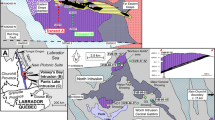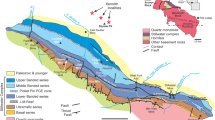Abstract
Electron and ion-probe microanalysis have been used to obtain zoning profiles for major and trace elements in olivine phenocrysts from a high-magnesian andesite from Shodo-Shima island, southwest Japan. This rock was previously thought to represent undifferentiated, primary magma. Some crystals have unzoned cores, while others show cores which are reversely zoned with respect to Mg/ (Mg+Fe), Ni, Mn and Cr. In addition, some Ni profiles show a normally zoned “hump” at the most central portions of the reversely zoned crystals. All crystals show normally zoned rims. The Li concentrations are constant throughout the cores of all crystals studied, but rise sharply, by a factor of up to at least six, in the rims. The Ca and Co concentrations are essentially constant throughout all the crystals. Mechanisms for producing the observed zoning profiles are discussed, and it is concluded that the reverse zoning was produced by the introduction of crystals into a less differentiated magma than that in which they grew. The reversely zoned crystals could therefore represent xenocrysts which were introduced into an undifferentiated magma, or phenocrysts introduced into a more primitive magma by a magma mixing process. The Ni profiles are used to estimate the residence time of these crystals in the more primitive magma. The following trace element partition co-efficients have been estimated for the olivine-groundmass system in this rock: D Ni=16; D Mn=1.1; D Co=4.2; D Ca =0.02; D Ti=0.005; D V=0.05; D Sc=0.2; D Na=0.0002. Studies of trace element zoning will become increasingly important as the new generation of trace element microprobes become available but a larger database of experimentally determined values for trace element partition coefficients and diffusion coefficients in crystals and magmas, and a better understanding of other disequilibrium processes are required to fully exploit the new data.
Similar content being viewed by others
References
Banner AE, Stimpson BF (1974) A combined ion probe/spark source analysis system. Vacuum 24:511–517
Brooks CK (1977) The Fe2O3/FeO ratio of basalt analyses: an appeal for a standardised procedure. Bull Geol Soc Denmark 25:117–120
Clark AM, Long JVP (1971) The anisotropic diffusion of nickel in olivine. In: Thomas Graham Memorial Symposium on diffusion processes. Gordon and Breach, London, pp 511–521
Colson RO, McKay GA, Taylor LA (1989) Charge balancing of trivalent trace elements in olivine and low-Ca pyroxene: A test using experimental partitioning data. Geochim Cosmochim Acta 53:643–648
Cooper AR Jr (1974) Vector space treatment of multicomponent diffusion In: Hofmann AW, Giletti BJ, Yoder HS, Yund RA (eds) Geochemical transport and kinetics. Carnegie Inst Washington publication 634, pp 15–30
Crank J (1956) The mathematics of diffusion. Oxford University Press
Duda A, Shimizu N (1986) An application of kinetic crystal growth models to trace element zoning in alkali basaltic clinopyroxenes. Mat Sci Forum 7:139–144
Gibb FGF (1974) Supercooling and the crystallisation of plagioclase from a basaltic magma. Mineral Mag 39:641–653
Henderson P (1982) Inorganic Geochemistry. Pergamon, Oxford New York
Henderson P, Nolan J, Cunningham GC, Lowry RK (1985) Structural controls and mechanisms of diffusion in natural silicate melts. Contrib Mineral Petrol 89:263–272
Hervig RL, Smith JV, Steele IM, Dawson JB (1980) Fertile and barren Al-Cr-spinel harzburgites from the upper mantle: ion and electron probe analyses of trace elements in olivine and orthopyroxene: Relation to lherzolites. Earth Planet Sci Lett 50:41–58
Irving AJ (1978) A review of experimental studies of crystal/liquid trace element partitioning. Geochim Cosmochim Acta 42:743–770
Ito J (1977) Crystal synthesis of a new olivine LiScSiO4. Am Mineral 62:356–361
Jurewicz AJG, Watson EB (1988a) Cations in olivine. Part I: Calcium partitioning and Ca-Mg distribution between olivines and coexisting melts: with petrologic applications. Contrib Mineral Petrol 99:176–185
Jurewicz AJG, Watson EB (1988b) Cations in olivine, Part II: Diffusion in olivine xenocrysts, with applications to petrology and mineral physics. Contrib Mineral Petrol 99:186–201
Kohn SC (1987) An experimental and analytical study of trace element partitioning in igneous systems. PhD Thesis, Univ of Manchester
Lofgren GE (1974) Temperature induced zoning in synthetic plagioclase feldspar. In: MacKenzie WS, Zussman J (eds) The feldspars. Manchester University Press
Long JVP, Astill DM, Coles JN, Reed SJB, Charnley NR (1980) A computer based recording system for high mass resolution ion-probe analysis. In: Beaman DR, Ogilvie RE, Wittry DB (eds) X-ray optics and microanalysis. Pendell Publishing Co, Midland, Michigan, pp 316–321
Longhi J, Walker D, Hays JF (1978) The distribution of Fe and Mg between olivine and lunar basaltic liquids. Geochim Cosmochim Acta 42:1545–1558
Luhr JF, Carmichael ISE (1980) The Colima volcanic complex, Mexico. I. Post-caldera andesites from Volcan Colima. Contrib Mineral Petrol 71:343–372
Mason RA, Parsons I, Long JVP (1985) Trace and minor element chemistry of alkali feldspars in the Klokken Layered Syenite Series. J Petrol 26:952–970
Mathieson GA (1987) Olivine-basaltic melt re-equilibration rates and their implication for crystallisation processes. PhD Thesis, University of Sheffield
Miyamoto M, Takeda H (1983) Atomic diffusion coefficients calculated for transition metals in olivine. Nature 306:602–603
Morioka M (1980) Cation diffusion in olivine — I. Cobalt and magnesium. Geochim Cosmochim Acta 44:759–762
Morioka M (1981) Cation diffusion in olivine — II. Ni-Mg, Mn-Mg, Mg and Ca. Geochim Cosmochim Acta 45:1573–1580
Nabelek PI, Langmuir CH (1986) The significance of unusual zoning in olivines from FAMOUS area basalt 527-1-1. Contrib Mineral Petrol 93:1–8
Roeder PL, Emslie RF (1970) Olivine-liquid equilibrium. Contrib Mineral Petrol 29:275–289
Sato H, Banno S (1983) NiO-Fo relation of magnesian olivine phenocryst in high-magnesian andesite and associated basaltandesite-sanukite from northeast Shikoku, Japan. Bull Volcanol Soc Japan 28:141–156
Seitz MG (1973) Boron mapping and partitioning in synthetic and natural systems; crystal melt assemblages, garnet, lherzolite, chondrites. Carnegie Inst Washington Yearb 72:588–593
Shimizu N (1978) Analysis of the zoned plagioclase of different magmatic environments: A preliminary ion-microprobe study. Earth Planet Sci Lett 39:398–406
Shimizu N, Hart SR (1982) Applications of the ion-microprobe to geochemistry and cosmochemistry. Ann Rev Earth Planet Sci 10:483–526
Sigurdsson H, Brown GM (1970) An unusual enstatite-forsterite basalt from Kolbeinsey island, north of Iceland. J Petrol 11:205–220
Steele IM, Hervig RL, Hutcheon ID, Smith JV (1981) Ion microprobe techniques and analyses of olivine and low-Ca pyroxene. Am Mineral 66:526–546
Takahashi E (1978) Partitioning of Ni2+, Co2+, Fe2+, Mn2+ and Mg2+ between olivine and silicate melts: compositional dependence of partition coefficient. Geochim Cosmochim Acta 42:1829–1844
Tatsumi Y (1982) Origin of high-magnesian andesites in the Setouchi volcanic belt, southwest Japan, II. Melting phase relations at high pressures. Earth Planet Sci Lett 60:305–317
Tatsumi Y, Ishizaka K (1982a) Origin of high-magnesian andesites in the Setouchi volcanic belt, southwest Japan. I. Petrographical and chemical characteristics. Earth Planet Sci Lett 60:293–304
Tatsumi Y, Ishizaka K (1982b) Magnesian andesite and basalt from Shodo-Shima Island, south west Japan, and their bearing on the genesis of calc-alkaline andesites. Lithos 15:161–172
Van Kooten GK, Buseck PR (1978) Interpretation of olivine zoning: a study of a maar from the San Francisco volcanic field, Arizona. Geol Soc Am Bull 89:744–754
Watson EB (1977) Partitioning of manganese between forsterite and silicate liquid. Geochim Cosmochim Acta 41:1363–1374
Yurimoto H, Sueno S (1984) Anion and cation partitioning between olivine, plagioclase phenocrysts and the host magma: A new application of ion microprobe study. Geochem J 18:85–94
Author information
Authors and Affiliations
Rights and permissions
About this article
Cite this article
Kohn, S.C., Henderson, C.M.B. & Mason, R.A. Element zoning trends in olivine phenocrysts from a supposed primary high-magnesian andesite: an electron- and ion-microprobe study. Contr. Mineral. and Petrol. 103, 242–252 (1989). https://doi.org/10.1007/BF00378510
Received:
Accepted:
Issue Date:
DOI: https://doi.org/10.1007/BF00378510




